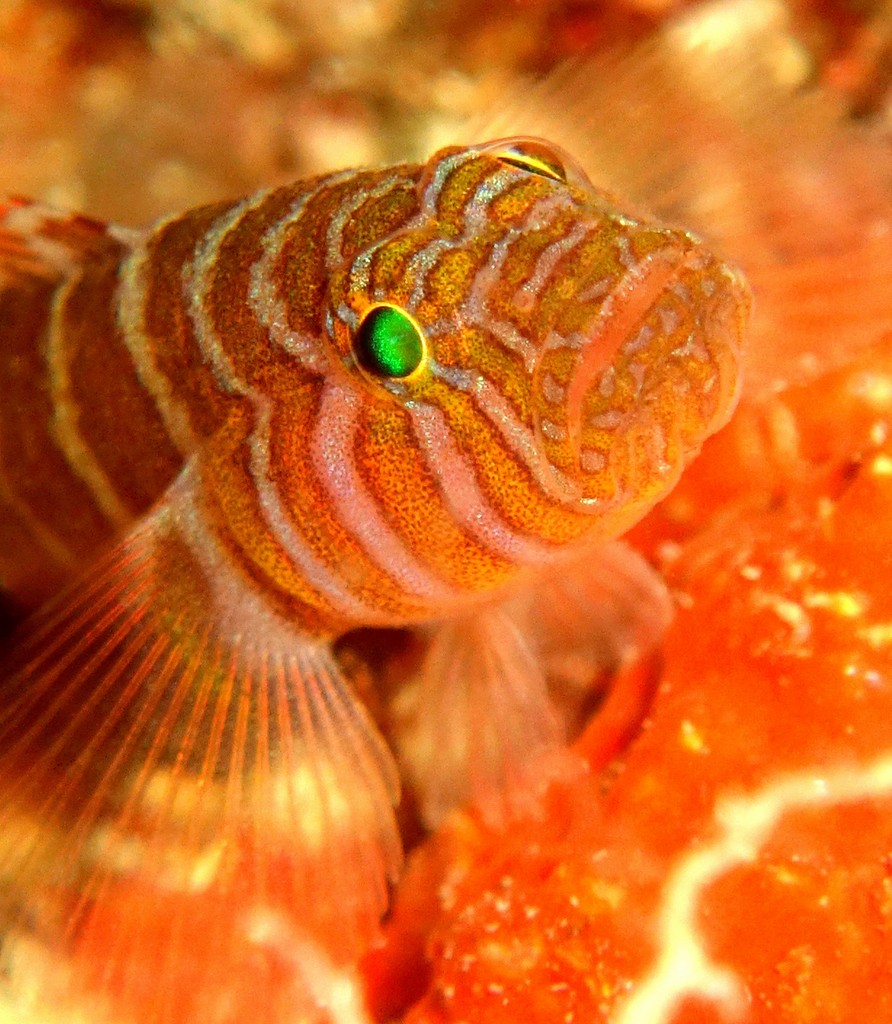PRIOLEPIS AKIHITOI - (HOESE & LARSON, 2010)
Picture courtesy of: Alain Daoulas
Emperor reefgoby, Kokuten-benkeihaze, コクテンベンケイハゼ,
Description
Dorsal spines (total): 7; Dorsal soft rays (total): 9-10; Anal spines: 1; Anal soft rays: 8; Pectoral fin rays: 20. Eyes slightly elevated resulting in a shallow pit in interorbital area and a shallow groove along dorsoposterior margin of eye; Ctenoid scales completely covering predorsal, reaching to above mideye, anteriormost scales sometimes cycloid, no naked patch immediately before the first dorsal spine; Small cycloid scales cover pectoral base; 11-13 rows of small cycloid scales cover prepelvic area; Cheek usually no scales, rarely with 1 or 2 scales near dorsoposterior margin of preoperculum; Operculum with a patch of small ctenoid scales dorsally; Sensory papilla rows on cheek with transverse pattern; Pelvic fins connected to form a plate, no interspinal membrane mouth oblique, forming an angle of about 40°-45° with body axis. Max. length: 5.3 cm SL. Depth range: 3 - 25 m.
Color
Head and body with narrow light bands, and with dark edges; A large elongate black spot anteriorly on first dorsal fin; 3-4 short vertical dark brown bars on dorsal part of caudal fin.
Etymology
Priolepis: from Greek, prion, -onos = saw + from Greek, lepis = a scale of a fish. Referring to ctenoid scales on body.
akihitoi: named for the Emperor of Japan, Akihito, for his significant and innovative contributions to the systematics of gobioid fishes.
Original description: Priolepis akihitoi Hoese & Larson, 2010 - Type locality: Futo, Ito City, Shizuoka Prefecture, Japan, depth 25 meters.
Distribution
Western Pacific: Japan, New Caledonia and Australia.
Biology
Hides in caves and crevices, also among corals or rock. Feeds on small invertebrates and zooplankton.
Similar species
Original description: Priolepis akihitoi Hoese & Larson, 2010 - Type locality: Futo, Ito City, Shizuoka Prefecture, Japan, depth 25 meters.
Distribution
Western Pacific: Japan, New Caledonia and Australia.
Biology
Hides in caves and crevices, also among corals or rock. Feeds on small invertebrates and zooplankton.
Similar species
- Priolepis cincta (Regan, 1908) - Reported from New Caledonia - Link to the species (here). Alternating dark-edged brown and narrower white bars on head and body; Dorsal and caudal fins with brown spotting; Basal part of dorsal fins with dark spots/bands.
- Priolepis pallidicincta (Winterbottom & Burridge, 1993) - Reported from Western Pacific: Brunei to Indonesia and Fiji, north to Philippines, south to Queensland (Australia). Alternating yellowish-brown and pale grey to whitish bars on head and body; Six broad yellow-brown bars on body.
- Priolepis profunda (Weber, 1909) - Reported from Indo-West Pacific: Kochi (southwestern India), Myanmar and Andaman Islands (India) east to Papua New Guinea, south to western Australia. Head and body brown with a distinct large black blotch at anterior base of first dorsal fin, and in life, head and body with very thin blue bands.
- Priolepis squamogena (Winterbottom & Burridge, 1989) - Reported from New Caledonia (Loyalty Islands). The color is very similar to that of Priolepis akihitoi, but is more yellow.
Last update: 5, May 2024
